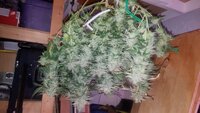Sask420grow
Well-Known Member
Here’s the debate. What should you use when selecting a light, par value or watt output. This was a post I made on another group that led to the debate of par value vs watt output. Apparently watt output is irrelevant now
So who using LED and is not aware they are scamming you when it comes to wattage? Basically the short of it is; they say it “puts out 2-3-4000w but only uses 400w of true power!” Ask yourself how 400w of true power from wall can be converted UP to 2-3-4000w. I didn’t understand and when told I denied until I did my research and sure enough!! ITS A SCAM for unsuspecting buyers. Ignorant buyers if you will. I bought a 2000w king plus led under the impression it will REPLACE my 1000w HPS magnetic ballast set up. Fact is it doesn’t. Fact is it won’t convert UP. They trick you by using 10w builds BUT those cannot be ran at full 10w so they are regulated to 3-4w for longevity and sustainability. You can take it apart and add peaces to force the 10w build to use 10w but then it only last a quarter it’s life expectancy. LED systems are a scam from what I’ve gathered. Especially the blurples. Some COBS and quantum boards are legit but the price reflects that. If your looking st getting an LED system, I strongly suggest doing a lot of research on them AND their competition. I bet you will save the money for the better units. That’s what I’m doing now lol. Good thing I still have the 1000w HPS magnetic lol
So who using LED and is not aware they are scamming you when it comes to wattage? Basically the short of it is; they say it “puts out 2-3-4000w but only uses 400w of true power!” Ask yourself how 400w of true power from wall can be converted UP to 2-3-4000w. I didn’t understand and when told I denied until I did my research and sure enough!! ITS A SCAM for unsuspecting buyers. Ignorant buyers if you will. I bought a 2000w king plus led under the impression it will REPLACE my 1000w HPS magnetic ballast set up. Fact is it doesn’t. Fact is it won’t convert UP. They trick you by using 10w builds BUT those cannot be ran at full 10w so they are regulated to 3-4w for longevity and sustainability. You can take it apart and add peaces to force the 10w build to use 10w but then it only last a quarter it’s life expectancy. LED systems are a scam from what I’ve gathered. Especially the blurples. Some COBS and quantum boards are legit but the price reflects that. If your looking st getting an LED system, I strongly suggest doing a lot of research on them AND their competition. I bet you will save the money for the better units. That’s what I’m doing now lol. Good thing I still have the 1000w HPS magnetic lol



